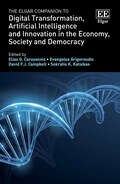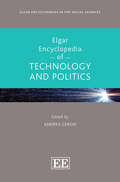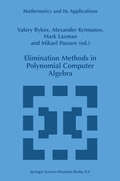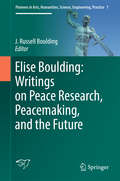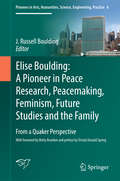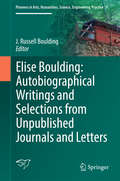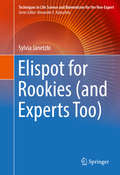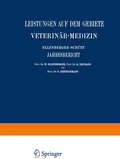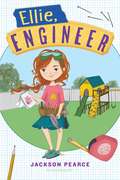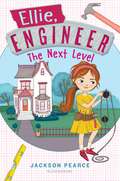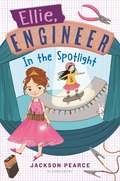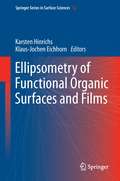- Table View
- List View
ELF and VLF Electromagnetic Field Effects
by Michael PersingerRecent emphasis upon the importance of the physical environment has made science and the public even more cog nizant of the many components of the biosphere. While much attention has been given to ionizing electromagnetic stimuli which causes blatant and unalterable changes in biological systems, relatively little research has been concerned with those electromagnetic signals whose frequencies overlap with time-varying processes in living organisms. Extremely low frequency (ELF) electromagnetic fields can occur as waves between about I Hz to 100 Hz or as short pulses within this range of very low frequency (VLF) and higher frequency sources. The natural occurrence of ELF signals is associated with weather changes, solar disturbances and geophysical ionospheric perturbations. Man-made sources have also been reported. Certain physical properties of ELF signals make them excellent candidates for biologically important stimuli. Unlike many other weather components, ELF signals have the capacity to penetrate structures which house living organ isms. ELF wave configurations allow long distance propaga tional capacities without appreciable attenuation of inten sity, thus making them antecedent stimuli to approaching weather changes. Most importantly, ELF signals exhibit the frequencies and wave forms of bio-electrical events that occur within the brain and body. Thus resonance inter actions between animal and nature become attractive possi bilities.
ELF-VLF Radio Wave Propagation: Proceedings of the NATO Advanced Study Institute held at Spåtind, Norway, April 17–27, 1974 (Nato Science Series C: #10)
by J. A. HoltetThis volume is based on lectures and discussions presented at a NATO Advanced Study Institute on ELF and VLF Radio Wave Propagation, which was held in Norway April 1974. The study of propagation of electromagnetic waves with frequen cies below 100 kHz has long traditions in ionospheric physics. To-day, this frequency range is still of great importance, both to the physicist, who uses the waves as diagnostic tools to study the earth's environment and to the engineer who exploits the characteris tics of these waves to improve communications, navigation and timing systems. In recent years the active interest in the field has led to very rapid progress in the development of propagation theory as well as in the application of this theory to the solution of practical problems. The intention of the Organizing Committee for this Conference was to bring together theoreticians and experi mentalists working on the various aspects of wave propagation, in order to stimulate a fruitful discussion and exchange of ideas.
The Elgar Companion to Digital Transformation, Artificial Intelligence and Innovation in the Economy, Society and Democracy
Digital transformation continues to accelerate change in all aspects of modern life. This book examines when, where, how, and why artificial intelligence and digital change can boost innovation and transform the economy, society and democracy. It provides a holistic approach to the promotion of the knowledge economy, knowledge society and knowledge democracy.The book is developed based on the Cyber-D4 nexus, which is a conceptual framework of Cyber-Defense, Cyber-Development, Cyber-Democracy, and Cyber-Diplomacy, and it adopts a Quadruple/Quintuple Innovation Helix (Q2IH) approach. This nexus ties new national and industrial cyber strategies, including business strategies for smart cities and the Internet of Things, with the local, national, regional, and global security and economic objectives.Academics, policy makers, practitioners, researchers and students in combined fields of science, technology, innovation and entrepreneurship, digital transformation, artificial intelligence and the future of industry will appreciate the lens through which the chapter authors explore both the minutiae and expansive influence of digital transformation.
Elgar Encyclopedia of Ecological Economics (Elgar Encyclopedias in Economics and Finance series)
With diverse contributions from over 100 authors around the globe, this comprehensive Encyclopedia summarises the developments of ecological economics from the fundamental contributions to the more recent methodological debates in the field.This Encyclopedia further reflects the relevant state of research including past and present major debates about particular concepts, theories, actors and issues at hand. It provides an expansive list of topics including sustainable development, the limits to growth, agroecology, implications of thermodynamic laws for economics, integrated ecologic-economic modelling, valuation of natural resources and services, and renewable and non-renewable resources management. With a strong normative focus, entries include theoretical, methodological, and empirical contributions, as the field orientates its efforts to improve environmental policy and governance to enhance wellbeing, environmental quality, and social justice.This unique reference will be a key tool to students, scholars, policy makers and anyone else seeking to understand the link between economic systems and the environment from the perspective of ecological economics, business management, environmental and urban studies.Key Features:Entries include selected references for further studyEntries by both leading scholars and up-and-coming voicesAddresses the links between the ecological crisis and economic activityOver 90 entries with accessible explanations of key concepts and methodsMulti-disciplinary approach across the fields of economics, ecology, sociology, geography, and also political science and history.
Elgar Encyclopedia of Technology and Politics (Elgar Encyclopedias in the Social Sciences series)
The Elgar Encyclopedia of Technology and Politics is a landmark resource that offers a comprehensive overview of the ways in which technological development is reshaping politics. Providing an unparalleled starting point for research, it addresses all the major contemporary aspects of the field.Divided into five thematic parts, the Encyclopedia investigates the existing academic literature on the main subfields in this area, before introducing innovative digital research methods. It then highlights the pivotal political and non-political actors leading the process of technological innovation, clarifies key concepts and terms in the field, and finally covers emerging and debated topics.This Encyclopedia will be particularly invaluable for early career researchers and advanced students in politics looking for a concise entry point into any of the various ways in which technology shapes the field. It will also be useful for practitioners to familiarise themselves with the analytical opportunities provided by computational social and political sciences.Key Features:Entries written by over 90 scholars from 33 different countries on 5 continentsAccessible starting point for research into the key literature, topics and debates in the fieldIntroduces important new digital methods such as machine learning, text analysis and network analysisDefines and clarifies the meaning of contested terms such as disinformation, echo chambers and fake news
Elie Cartan and Albert Einstein: Letters on Absolute Parallelism, 1929-1932
by Robert DebeverPublished here in the original German and French, along with an English translation, the correspondence between Albert Einstein and Elie Cartan includes letters written between 1929 and 1932, after which time Einstein abandoned his unified field theory based on absolute parallelism.Originally published in 1979.The Princeton Legacy Library uses the latest print-on-demand technology to again make available previously out-of-print books from the distinguished backlist of Princeton University Press. These editions preserve the original texts of these important books while presenting them in durable paperback and hardcover editions. The goal of the Princeton Legacy Library is to vastly increase access to the rich scholarly heritage found in the thousands of books published by Princeton University Press since its founding in 1905.
Elimination Methods in Polynomial Computer Algebra (Mathematics and Its Applications #448)
by V. Bykov A. Kytmanov M. Lazman Mikael PassareThe subject of this book is connected with a new direction in mathematics, which has been actively developed over the last few years, namely the field of polynomial computer algebra, which lies at the intersection point of algebra, mathematical analysis and programming. There were several incentives to write the book. First of all, there has lately been a considerable interest in applied nonlinear problems characterized by multiple sta tionary states. Practical needs have then in their turn led to the appearance of new theoretical results in the analysis of systems of nonlinear algebraic equations. And finally, the introduction of various computer packages for analytic manipulations has made it possible to use complicated elimination-theoretical algorithms in prac tical research. The structure of the book is accordingly represented by three main parts: Mathematical results driven to constructive algorithms, computer algebra realizations of these algorithms, and applications. Nonlinear systems of algebraic equations arise in diverse fields of science. In particular, for processes described by systems of differential equations with a poly nomial right hand side one is faced with the problem of determining the number (and location) of the stationary states in certain sets.
The ELISA Guidebook: Second Edition (Methods in Molecular Biology #149)
by John R. CrowtherJohn R. Crowther provides today's premier practical guide to the understanding and application of ELISA. Updating and greatly expanding his widely appreciated earlier publication, ELISA Theory and Practice (1995), this important work introduces chapters on such major new topics as checkerboard titrations, quality control of testing, kit production and control, novel monoclonal antibodies, validation of assays, statistical requirements for data examination, and epidemiological considerations. With its numerous worked examples, detailed instructions, and extensive illustrations, The ELISA Guidebook offers a powerful synthesis of all the basic concepts and practical experimental details investigators need to understand, develop, and apply the new ELISA methodology successfully in day-to-day basic and clinical research.
Elise Boulding: Writings On Peace Research, Peacemaking, And The Future (Pioneers in Arts, Humanities, Science, Engineering, Practice #7)
by J. Russell BouldingThis volume honors the lifetime achievements of the distinguished activist and scholar Elise Boulding (1920–2010) on the occasion of her 95th birthday. Known as the “matriarch” of the twentieth century peace research movement, she made significant contributions in the fields of peace education, future studies, feminism, and sociology of the family, and as a prominent leader in the peace movement and the Society of Friends. She taught at the University of Colorado, Boulder from 1967 to 1978 and at Dartmouth College from 1978 to 1985, and was instrumental in the development of peace studies programs at both institutions. She was a co-founder of the International Peace Research Association (1964), the Consortium on Peace Research Education and Development (1970), and various peace and women’s issues-related committees and working groups of the American Sociological Association and International Sociological Association.
Elise Boulding: From a Quaker Perspective (Pioneers in Arts, Humanities, Science, Engineering, Practice #6)
by J. Russell BouldingThis series of four volumes honors the lifetime achievements of the distinguished activist and scholar Elise Boulding (1920–2010) on the occasion of her 95th birthday. This first anthology documents the breadth of Elise Boulding’s contributions to Peace Research, Peacemaking, Feminism, Future Studies, and Sociology of the Family. Known as the “matriarch” of the twentieth century peace research movement, she made significant contributions in the fields of peace education, future studies, feminism, and sociology of the family, and as a prominent leader in the peace movement and the Society of Friends.
Elise Boulding: Autobiographical Writings and Selections from Unpublished Journals and Letters (Pioneers in Arts, Humanities, Science, Engineering, Practice #9)
by J Russell BouldingThis volume honors the lifetime achievement of distinguished activist and scholar Elise Boulding (1920–2010) on the occasion of her 96th birthday. Known as the “matriarch” of the twentieth century peace research movement, she made significant contributions in the fields of peace education, future studies, feminism, and sociology of the family, as well as serving as a prominent leader in the peace movement and the Society of Friends. She taught at the University of Colorado, Boulder from 1967 to 1978 and at Dartmouth College from 1978 to 1985, and was instrumental in the development of peace studies programs at both those institutions. She was a co-founder of the International Peace Research Association (1964), the Consortium on Peace Research Education and Development (1970), and various peace and women’s issue related committees and working groups of the American Sociological Association and International Sociological Association.
Elise Boulding: Writings on Feminism, the Family and Quakerism (Pioneers in Arts, Humanities, Science, Engineering, Practice #8)
by J. Russell BouldingThis volume honors the lifetime achievements of the distinguished activist and scholar Elise Boulding (1920–2010) on the occasion of her 95th birthday. Known as the “matriarch” of the twentieth century peace research movement, she made significant contributions in the fields of peace education, future studies, feminism, and sociology of the family, and as a prominent leader in the peace movement and the Society of Friends. She taught at the University of Colorado, Boulder from 1967 to 1978 and at Dartmouth College from 1978 to 1985, and was instrumental in the development of peace studies programs at both institutions. She was a co-founder of the International Peace Research Association (1964), the Consortium on Peace Research Education and Development (1970), and various peace and women’s issues-related committees and working groups of the American Sociological Association and International Sociological Association.
Elispot for Rookies (Techniques in Life Science and Biomedicine for the Non-Expert)
by Sylvia JanetzkiThis book provides basic, simple, and logical explanations for choices to be made to run the best Elispot possible. It allows the newcomer to truly understand the best options for specific protocol steps, reagents and materials, and provides even the experienced Elispot user with insight into best practices. The techniques presented here are supported by the author’s twenty-plus years of first-hand experience working with this assay, as well as the shared experiences of numerous colleagues and collaborators.The enzyme-linked immunospot (Elispot) assay is a widely used technique to monitor cells on the single cell level for the release of analytes like cytokines, chemokines or immunoglobulins (antibodies), in response to particular stimuli. The most important feature of Elispot is its outstanding sensitivity, allowing the detection of specific cells in very low frequencies. The advantages of Elispot have resulted in it being widely adapted for use in research and translational applications in numerous fields including cancer, infectious diseases, autoimmunity, and transplantation.
Elixir: A Parisian Perfume House and the Quest for the Secret of Life
by Theresa LevittA story of alchemy in Bohemian Paris, where two scientific outcasts discovered a fundamental distinction between natural and synthetic chemicals that inaugurated an enduring scientific mystery.For centuries, scientists believed that living matter possessed a special quality—a spirit or essence—that differentiated it from nonliving matter. But by the nineteenth century, the scientific consensus was that the building blocks of one were identical to the building blocks of the other. Elixir tells the story of two young chemists who were not convinced, and how their work rewrote the boundary between life and nonlife.In the 1830s, Édouard Laugier and Auguste Laurent were working in Laugier Père et Fils, the oldest perfume house in Paris. By day they prepared the perfumery’s revitalizing elixirs and rejuvenating eaux, drawing on alchemical traditions that equated a plant’s vitality with its aroma. In their spare time they hunted the vital force that promised to reveal the secret to life itself. Their ideas, roundly condemned by established chemists, led to the discovery of structural differences between naturally occurring molecules and their synthetic counterparts, even when the molecules were chemically identical.Scientists still can’t explain this anomaly, but it may point to critical insights concerning the origins of life on Earth. Rich in sparks and smells, brimming with eccentric characters, experimental daring, and the romance of the Bohemian salon, Elixir is a fascinating cultural and scientific history.
Elixir: A Story of Perfume, Science and the Search for the Secret of Life
by Theresa Levitt'Dizzying and fragrant . . . truly a captivating achievement!' Aimee Nezhukumatathil'If you read this book you will be changed . . . this book feels like an actual elixir' Kiese Laymon'A fascinating tale of discovery, wonder, and revolution' Matthew StanleyTwo friends in a Parisian perfume shop make a discovery that will transform our understanding of the world and the origins of life on Earth forever.Set amidst the unforgettable sights and smells of 18th and 19th Century Paris, Elixir tells the story of Edouard Laugier and Auguste Laurent, the son of a perfumer and a fellow aspiring chemist, who met on the Left Bank while pursuing their passion for science. Spurned by the scientific establishment, the pair ended up working out of Edouard's family perfume shop, Laugier père et fils. By day they prepared the revitalizing elixirs and rejuvenating eaux it was famous for, but by night using the ingredients of the perfumery and the principles of alchemy, they pursued the secret of life itself.Elixir reads like a novel, brimming with eccentric characters, experimental daring, and the romance of the Bohemian salon. It is the story of a long-standing scientific puzzle and the struggle to gain acceptance for a new way of thinking about the building blocks of living matter long after those who discovered it were both dead. Yet this is also a story of hope and determination. For while the scientific establishment ridiculed their work at the time, teenage lab assistant Louis Pasteur took it seriously and over the course of an exceptional career, was able to show that their work pointed to a deep, inexplicable asymmetry in the molecular arrangement of living things - an unexplained asymmetry which remains one of science's great mysteries.
Eliza Scidmore: The Trailblazing Journalist Behind Washington's Cherry Trees
by Diana P. Parsell'A wonderful connecting of two women writers' stories more than a century apart.' Julia Kuehn, The University of Hong Kong The first-ever biography of the pioneering female journalist who fought to bring Japanese cherry trees to Washington, DC Every age has strong, independent women who defy the gender conventions of their era to follow their hearts and minds. Eliza Scidmore was one such maverick. Born on the American frontier just before the Civil War, she rose from modest beginnings to become a journalist who roamed far and wide writing about distant places for readers back home. By her mid-20s she had visited more places than most people would see in a lifetime. By the end of the nineteenth century, her travels were so legendary she was introduced at a meeting in London as “Miss Scidmore, of everywhere.” In what has become her best-known legacy, Scidmore carried home from Japan a big idea that helped shape the face of modern Washington: she urged the city's park officials to plant Japanese cherry trees on a reclaimed mud bank-today's Potomac Park. Though they rebuffed her suggestion several times, she finally got her way nearly three decades later thanks to the support of First Lady Helen Taft. Scidmore was a “Forrest Gump” of her day who bore witness to many important events and rubbed elbows with famous people, from John Muir and Alexander Graham Bell to U.S presidents and Japanese leaders. She helped popularize Alaska tourism during the birth of the cruise industry, and educated readers about Japan and other places in the Far East at a time of expanding U.S. interests across the Pacific. At the early National Geographic, she made a lasting mark as the first woman to serve on its board and to publish photographs in the magazine. Around the same time, she also played an activist role in the burgeoning U.S. conservation movement. Her published work includes books on Alaska, Japan, Java, China, and India; a novel based on the Russo-Japanese War; and about 800 articles in U.S. newspapers and magazines. Deeply researched and briskly written, this first-ever biography of Scidmore draws heavily on her own writings to follow major events of a half-century as seen through the eyes of a remarkable woman who was far ahead of her time.
Eliza Scidmore: The Trailblazing Journalist Behind Washington's Cherry Trees
by Diana P. Parsell'A wonderful connecting of two women writers' stories more than a century apart.' Julia Kuehn, The University of Hong Kong The first-ever biography of the pioneering female journalist who fought to bring Japanese cherry trees to Washington, DC Every age has strong, independent women who defy the gender conventions of their era to follow their hearts and minds. Eliza Scidmore was one such maverick. Born on the American frontier just before the Civil War, she rose from modest beginnings to become a journalist who roamed far and wide writing about distant places for readers back home. By her mid-20s she had visited more places than most people would see in a lifetime. By the end of the nineteenth century, her travels were so legendary she was introduced at a meeting in London as “Miss Scidmore, of everywhere.” In what has become her best-known legacy, Scidmore carried home from Japan a big idea that helped shape the face of modern Washington: she urged the city's park officials to plant Japanese cherry trees on a reclaimed mud bank-today's Potomac Park. Though they rebuffed her suggestion several times, she finally got her way nearly three decades later thanks to the support of First Lady Helen Taft. Scidmore was a “Forrest Gump” of her day who bore witness to many important events and rubbed elbows with famous people, from John Muir and Alexander Graham Bell to U.S presidents and Japanese leaders. She helped popularize Alaska tourism during the birth of the cruise industry, and educated readers about Japan and other places in the Far East at a time of expanding U.S. interests across the Pacific. At the early National Geographic, she made a lasting mark as the first woman to serve on its board and to publish photographs in the magazine. Around the same time, she also played an activist role in the burgeoning U.S. conservation movement. Her published work includes books on Alaska, Japan, Java, China, and India; a novel based on the Russo-Japanese War; and about 800 articles in U.S. newspapers and magazines. Deeply researched and briskly written, this first-ever biography of Scidmore draws heavily on her own writings to follow major events of a half-century as seen through the eyes of a remarkable woman who was far ahead of her time.
Elizabeth Barrett Browning and Robert Browning: Interviews and Recollections
by NA NAElizabeth Barrett Browning and Robert Browning: Interviews and Recollections gathers accounts of the two poets from her precocious childhood to his death in Venice. Comments by Nathaniel and Sophia Hawthorne, Alfred Tennyson, Henry James, Edmund Gosse and the Brownings themselves are included together with the reports or recollections of many less well known contemporaries. There is material on Barrett Browning's relationship with her father, her spiritualism, appearance, ambitions and convictions as a poet, and `devotion to and faith in the regeneration of Italy'; and on Browning's early friendship with Carlyle, his fraught relationship with Macready and the theatre, his love of fine clothes and society, and work habits. Some contemporary accounts construct, while others reject or qualify, familiar images of the poets: Barrett Browning as the frail, safely female recluse, for instance, or Browning as the loud and trivial talker who was so different from his poetry that for James there were simply `two Brownings'.
Ellenberger-Schütz’ Jahresbericht über die Leistungen auf dem Gebiete der Veterinär-Medizin: Fünfundvierzigster Jahrgang(Jahr 1925)
by St. Angeloff M. Schristiansen NA Constantinecu H. Dexler A. Fischer L. Freund Frick St. Gajewski Götze W. Grimmer K. Heuss NA Hnsersson F. v. Hutyra C.O. Jensen E. JoestDieser Buchtitel ist Teil des Digitalisierungsprojekts Springer Book Archives mit Publikationen, die seit den Anfängen des Verlags von 1842 erschienen sind. Der Verlag stellt mit diesem Archiv Quellen für die historische wie auch die disziplingeschichtliche Forschung zur Verfügung, die jeweils im historischen Kontext betrachtet werden müssen. Dieser Titel erschien in der Zeit vor 1945 und wird daher in seiner zeittypischen politisch-ideologischen Ausrichtung vom Verlag nicht beworben.
Ellie, Engineer (Ellie, Engineer)
by Jackson PearceEllie is an engineer. With a tool belt strapped over her favorite skirt (who says you can't wear a dress and have two kinds of screwdrivers handy, just in case?), she invents and builds amazing creations in her backyard workshop. Together with her best friend Kit, Ellie can make anything. As Kit's birthday nears, Ellie doesn't know what gift to make until the girls overhear Kit's mom talking about her present--the dog Kit always wanted! Ellie plans to make an amazing doghouse, but her plans grow so elaborate that she has to enlist help from the neighbor boys and crafty girls, even though the two groups don't get along. Will Ellie be able to pull off her biggest project yet, all while keeping a secret from Kit? Illustrated with Ellie's sketches and plans, and including backmatter with a fun how-to guide to tools, this is a STEM- and friendship-powered story full of fun!
Ellie, Engineer: The Next Level (Ellie, Engineer)
by Jackson PearceEllie the Engineer is back in another charming, hilarious, illustrated story filled with creative, STEM-powered fun! "Look out, Junie B. Jones! Ellie the engineer is thinking, making, creating, and showing enthusiasm and brilliance with her creations!" -School Library Connection on Ellie, EngineerAfter Ellie's first elevator build goes terribly wrong, her parents decide her "punishment" is to assist an elderly neighbor, Mrs. Curran, around the house. Ellie and her friends Kit and Toby are really only supposed to help with little things, but Ellie can't turn down the opportunity to use her engineering skills here and there where she sees a need--because that's what engineers do! It's no fun, though, when Mrs. Curran always gives Toby the credit for all the ingenious projects, and acts like Kit and Ellie were just helping him. . . . Can Ellie come up with another great build to elevate Mrs. Curran's ideas about this girl engineer?With Ellie's designs and sketches throughout, and her fun guide to simple machines in the back, the continuation of this delightful series will leave young readers laughing and inspired to create.
Ellie, Engineer: In the Spotlight (Ellie, Engineer)
by Jackson PearceEllie the Engineer is back in a third charming, hilarious, illustrated story filled with creative, STEM-powered fun!"Look out, Junie B. Jones! Ellie the engineer is thinking, making, creating, and showing enthusiasm and brilliance with her creations!" - School Library Connection on Ellie, EngineerEllie enters a pageant with her best friend Kit, which means lots of glitter, hairspray, and chances to make new friends. After all, Ellie has lots of engineering ideas to help the other girls with their talents, like building a light-up skateboard ramp for Kit! But one contestant, Kit's not-so-nice pageant rival Melody, makes fun of Ellie's tool belt and thinks engineering is messy. And when Melody's rabbit--part of her magic act--goes missing, Ellie knows that she can build a contraption to catch him. But Melody's comments have made Ellie start to doubt herself--what if a pageant isn't a place for engineering?With Ellie's designs and sketches throughout, and her fun guide to electricity and circuits in the back, the continuation of this delightful series will leave young readers laughing and inspired to create.
Ellipsometry for Industrial Applications
by Karl RiedlingDuring the past years, elliposometry, a non-destructive and contact-less optical surface analysis technique, has gained increased importance in industrial areas, such as the technology of electronic devices, when simple instruments, many of them computer-controlled and automated, became available. The potential users of such instruments are, however, frequently aware neither of the inherent possibilities of this technique, nor of its accuracy limitations. This book endeavors to point out some of the less obvious features and possibilities of ellipsometry, particularly of dynamic "in situ" measurements, and reviews its applications in research and manufacturing of semiconductor and thin film devices. A comprehensive discussion of various error effects typical particularly for simple ellipsometers and of their impact on measured sample parameters is provided. Error correction or (numerical) calibration procedures are given wherever possible, and design and operation guidelines for high-speed instruments suitable for dynamic "in situ" measurements are suggested.
Ellipsometry of Functional Organic Surfaces and Films (Springer Series in Surface Sciences #52)
by Karsten Hinrichs Klaus-Jochen EichhornThis new edition provides a state-of-the-art survey of ellipsometric methods used to study organic films and surfaces, from laboratory to synchrotron applications, with a special focus on in-situ use in processing environments and at solid-liquid interfaces. Thanks to the development of functional organic, meta- and hybrid materials for new optical, electronic, sensing and biotechnological devices, the ellipsometric analysis of optical and material properties has made tremendous strides over the past few years.The second edition has been updated to reflect the latest advances in ellipsometric methods. The new content focuses on the study of anisotropic materials, conjugated polymers, polarons, self-assembled monolayers, industrial membranes, adsorption of proteins, enzymes and RGD-peptides, as well as the correlation of ellipsometric spectra to structure and molecular interactions.
Ellipsometry of Functional Organic Surfaces and Films (Springer Series in Surface Sciences #52)
by Karsten Hinrichs Klaus-Jochen EichhornEllipsometry is the method of choice to determine the properties of surfaces and thin films. It provides comprehensive and sensitive characterization in contactless and non-invasive measurements. This book gives a state-of-the-art survey of ellipsometric investigations of organic films and surfaces, from laboratory to synchrotron applications, with a special focus on in-situ use in processing environments and at solid-liquid interfaces. In conjunction with the development of functional organic, meta- and hybrid materials for new optical, electronic, sensing and biotechnological devices and fabrication advances, the ellipsometric analysis of their optical and material properties has progressed rapidly in the recent years.


